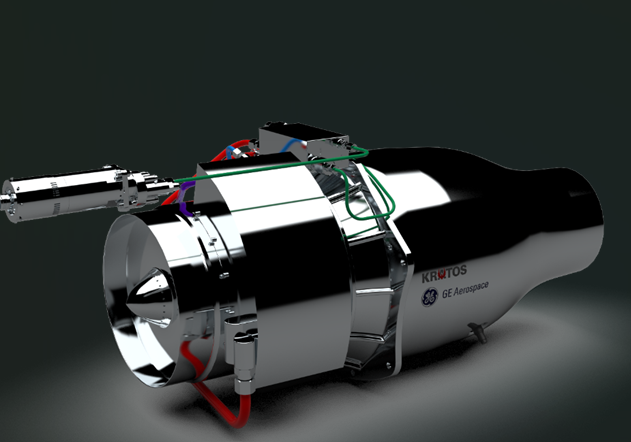
GEK1500 engine. (Photo: GE Aerospace and Kratos)
EVENDALE, Ohio—GE Aerospace is expanding its work with Kratos Defense & Security Solutions on low-cost, small turbofan engines, announcing plans to develop a new 1,500-pound thrust capability aimed at powering the “lower end” of Collaborative Combat Aircraft designs.
Company officials told reporters the new GEK1500 engine, slated for an initial prototype demo in 2026, is a scaled-up version of the in-development GEK800 expendable engine, which is aimed at powering capabilities such as cruise missiles and is set for further testing this summer.
Mark Rettig, vice president & general manager of GE Aerospace’s Edison Works Advanced Programs, noted the partnership with Kratos began in 2023 with a joint development agreement to work on the GEK800, with the new teaming agreement aimed at developing a range of propulsion solutions.
“Kratos is fast. They have much more flexibility. [They do] limited reviews. [There’s] a lot more ability to make decisions at lower levels. [Our] teams fit so well together,” Retting said at a briefing here at the company’s headquarters.
GE Aerospace and Kratos first detailed their low-cost small engine work last year, noting the intent is to partner on full-scale engine production.
In a statement on June 2, GE Aerospace cited Kratos’ two decades of experience building small engines for drones and missile platforms and said the capabilities in development will offer “affordable mass propulsion solutions across a range of next-generation defense applications for the Department of Defense.”
Steve “Doogie” Russell, vice president & general manager at GE Aerospace Edison Works, noted the engines the company builds for combat aircraft and helicopters are designed to survive thousands of cycles.
“Starting at a low-cost model for [a platform] that only has to survive a couple of cycles that may give you a few hours [of use] is a completely different approach from a business standpoint. And that’s part of why we partnered with Kratos,” Russell told reporters. ”If we just took what we do for the highest, most capable engines and tried to scale it down, we would never get the cost or the performance that we need for these lower cost, small engines. And that’s why we’ve taken a completely different approach to that. And we think that business model is innovative.”
Stacey Rock, president of Kratos’ turbine technologies division, said his firm is “good at going fast and being affordable” and teaming with GE Aerospace will bolster the company’s production capacity and provide “long-term agreements for suppliers.”
Russell said the pursuit of the larger GEK1500 follows DoD’s interest in “portable combat mass,” such as CCAs, and was “based on discussions with where we think the government may or may not be going but also [in talking] with various platform providers, both the more traditional ones and the more disruptive type of platform providers.
The Air Force has been developing uncrewed CCAs it envisions as drone “wingmen” supporting future manned fighters.
For the smaller 800-pound thrust GEK800, Russell said the aim is to develop an engine for cruise missiles that can “meet or beat” the current price of around “a couple hundred [thousand] while offering “enhanced performance.”
Rock noted that work on the GEK800 began with a mix of internal funding and some support from the Air Force with an aim for further development of a capability for advanced cruise missile market.
“I think it’s pretty widely known that there are not a large number of engines that are available in that class for these systems. And with the numbers that are being projected [for what is] going to be produced in the coming years, there was a strong pull for an alternate engine,” Rock said.
Craig Young, GE Aerospace’s executive engineering director for hypersonic propulsion & small UAV engines, told reporters an altitude test is planned for this summer with the GEK800 tech demonstrator engine, with plans to build the first product engine by December or January and a second engine a month a half later.
Russell noted GE Aerospace and Kratos have a “longer-term roadmap, which we’re not quite ready to share yet” or expanding on the family of small engines, with Rettig adding the companies see the engines on a spectrum from “expendable to reusable.”
“There is more scalability opportunity in this particular architecture, but right now we’ve got two engines under development and are continuing to move forward,” Rettig said.
A version of this story originally appeared in affiliate publication Defense Daily.